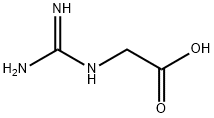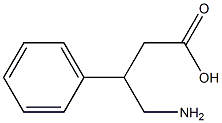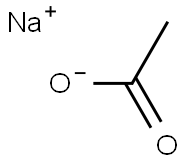Guanidineacetic acid
Synonym(s):N-Amidinoglycine;N-Guanylglycine;Glycocyamine
- CAS NO.:352-97-6
- Empirical Formula: C3H7N3O2
- Molecular Weight: 117.11
- MDL number: MFCD00004278
- EINECS: 206-529-5
- SAFETY DATA SHEET (SDS)
- Update Date: 2025-12-19 17:28:17

What is Guanidineacetic acid?
Chemical properties
WHITE TO SLIGHTLY BEIGE FINE CRYSTALLINE POWDER
The Uses of Guanidineacetic acid
An important marker for renal failure, in kidney transplantation, and for the renal metabolic activity.
The Uses of Guanidineacetic acid
Guanidinoacetic Acid is an important marker for renal failure, in kidney transplantation, and for the renal metabolic activity.
What are the applications of Application
Guanidinoacetic Acid is used as a substrate for the assay of glycocyamine kinase
Definition
ChEBI: The N-amidino derivative of glycine.
Purification Methods
Recrystallise it from 15 parts of hot H2O, or by dissolving it in slightly more than the calculated amount of 2N HCl and precipitating it by adding an equivalent of 2N NaOH, filtering, washing with cold H2O and drying first in vacuo, then at 60o in vacuo. The hydrochloride has m 200o(dec) after recrystallisation from aqueous HCl as plates. The picrate forms needles from hot H2O with m 210o(dec). [Brand & Brand Org Synth Coll Vol III 440 1955, Failey & Brand J Biol Chem 102 768 1933, King J Chem Soc 2375 1930, Beilstein 4 H 359, 4 I 477, 4 II 793, 4 III 1165.]
Properties of Guanidineacetic acid
| Melting point: | 300 °C(lit.) |
| Boiling point: | 218.88°C (rough estimate) |
| Density | 1.4020 (rough estimate) |
| refractive index | 1.4900 (estimate) |
| storage temp. | Keep in dark place,Inert atmosphere,Room temperature |
| solubility | 6 M NaOH : 50 mg/mL, clear, colorless |
| form | Solid |
| pka | 2.82(at 25℃) |
| color | White to Off-White |
| Water Solubility | 3.6g/L(15 ºC) |
| Merck | 14,4495 |
| BRN | 1759179 |
| CAS DataBase Reference | 352-97-6(CAS DataBase Reference) |
| EPA Substance Registry System | Glycocyamine (352-97-6) |
Safety information for Guanidineacetic acid
| Signal word | Warning |
| Pictogram(s) |
 Exclamation Mark Irritant GHS07 |
| GHS Hazard Statements |
H315:Skin corrosion/irritation H319:Serious eye damage/eye irritation H335:Specific target organ toxicity, single exposure;Respiratory tract irritation |
| Precautionary Statement Codes |
P261:Avoid breathing dust/fume/gas/mist/vapours/spray. P264:Wash hands thoroughly after handling. P264:Wash skin thouroughly after handling. P280:Wear protective gloves/protective clothing/eye protection/face protection. P304+P340:IF INHALED: Remove victim to fresh air and Keep at rest in a position comfortable for breathing. P305+P351+P338:IF IN EYES: Rinse cautiously with water for several minutes. Remove contact lenses, if present and easy to do. Continuerinsing. P405:Store locked up. |
Computed Descriptors for Guanidineacetic acid
| InChIKey | BPMFZUMJYQTVII-UHFFFAOYSA-N |
New Products
4,4-Difluoropiperidine hydrochloride tert-butyl 9-methoxy-3-azaspiro[5.5]undecane-3-carboxylate Indole Methyl Resin N-Isopropylurea N,N-Dicyclohexylcarbodiimide(DCC) MELDRUMS ACID 5-METHYLISOXAZOLE-4-CARBOXYLIC ACID Magnessium Bis glycinate Zinc ascorbate 1-bromo-2-butyne 2-acetamidophenol 9(10H)-anthracenone Erythrosin B, 4-Piperidinopiperidine 2-((4-morpholinophenylamino) (methylthio) methylene) malononitrile 2,4-dihydroxybenzaldehyde 3-(4-morpholinophenylamino)-5-amino-1H-pyrazole-4-carbonitrile Methyl 2-methylquinoline-6-carboxylate 2,6-dichloro-4-nitropyridine 4-Bromo-2-chlorobenzonitrile 2-(benzylamino)acetic acid hydrochloride 4-(tert-Butoxycarbonylamino)but- 2-ynoic acid 3,4-dihydro-2H-benzo[b][1,4]dioxepine 1-Phenyl-1-cycloprppanecarboxylicacidRelated products of tetrahydrofuran








You may like
-
 Glycocyamine 98% CAS 352-97-6View Details
Glycocyamine 98% CAS 352-97-6View Details
352-97-6 -
 Glycocyamine CAS 352-97-6View Details
Glycocyamine CAS 352-97-6View Details
352-97-6 -
 Guanidineacetic acid CAS 352-97-6View Details
Guanidineacetic acid CAS 352-97-6View Details
352-97-6 -
 3-(4-amino-1-oxoisoindolin-2-yl)-1-methylpiperidine-2,6-dione 98%View Details
3-(4-amino-1-oxoisoindolin-2-yl)-1-methylpiperidine-2,6-dione 98%View Details -
 20677-73-0 (2,2-diethoxyethyl)methylamine 98%View Details
20677-73-0 (2,2-diethoxyethyl)methylamine 98%View Details
20677-73-0 -
 3-(4-(hydroxyamino)-1-oxoisoindolin-2-yl)piperidine-2,6-dione 98%View Details
3-(4-(hydroxyamino)-1-oxoisoindolin-2-yl)piperidine-2,6-dione 98%View Details -
 57381-49-4 2-bromo-4-chlorobenzonitrile 98%View Details
57381-49-4 2-bromo-4-chlorobenzonitrile 98%View Details
57381-49-4 -
 4,6-dichloropyrimidine-5-carbaldehyde 98%View Details
4,6-dichloropyrimidine-5-carbaldehyde 98%View Details
5305-40-8
